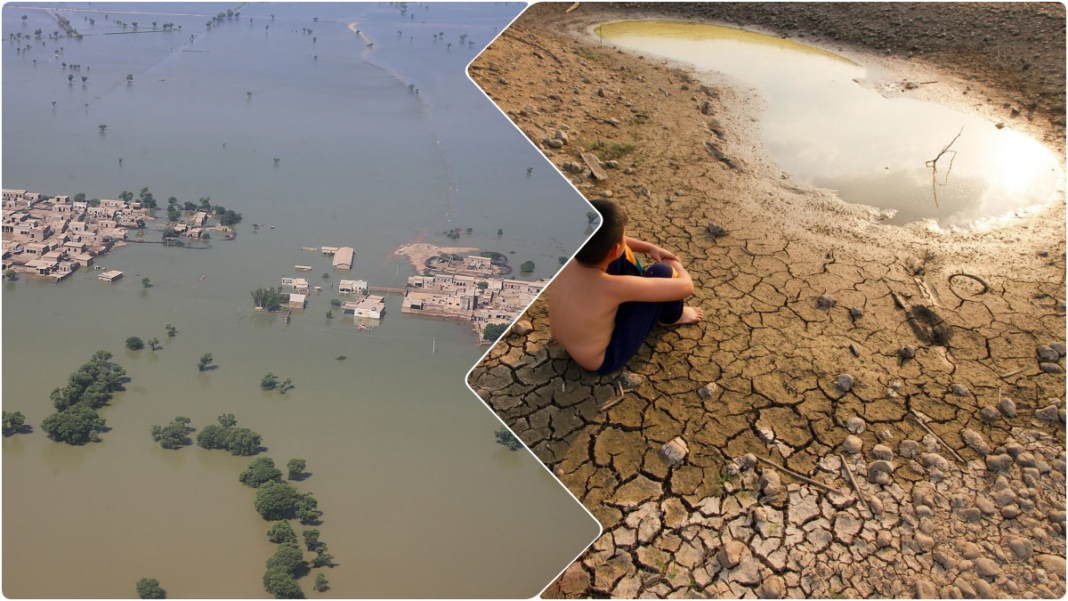By: Maqsood Shahi
Pakistan is grappling with the profound impacts of climate change. The situation in Pakistan is particularly dire due to the complex phenomenon of historical legacies, economic structures, and geopolitical realities. The climate crisis in Pakistan cannot be understood in isolation; it is intricately linked to the nation’s colonial past, its post-colonial economic trajectory, and its position within the global economic system.
During the British colonial period, Pakistan, then part of British India, experienced significant environmental alterations due to the colonial administration’s extractive economic policies. The British Empire’s focus was on maximizing resource extraction to fuel industrial growth back home. This resulted in extensive deforestation, soil erosion, and the introduction of large-scale monoculture plantations that degraded the land and biodiversity. The colonial emphasis on cash crops like cotton and indigo disrupted traditional agricultural systems, causing long-term damage to the soil and water resources. The construction of vast irrigation networks, such as the Indus Basin Irrigation System, while increasing agricultural productivity in the short term, led to severe issues of waterlogging and salinity over time.
After gaining independence in 1947, Pakistan continued to follow a development model heavily reliant on resource extraction and agriculture. This path perpetuated many of the environmental challenges inherited from the colonial era. The agricultural sector, which employs nearly 40% of the workforce and contributes around 20% to the GDP, is highly vulnerable to the impacts of climate change. Erratic rainfall patterns, increasing temperatures, and the melting of Himalayan glaciers directly threaten the water supply critical for irrigation.
Economic constraints further exacerbate Pakistan’s climate vulnerability. The country faces significant financial and technological barriers in its efforts to mitigate and adapt to climate change. As a developing nation, Pakistan has limited resources to invest in climate-resilient infrastructure or renewable energy. The global economic system often marginalizes countries like Pakistan, which struggle to attract sufficient international funding and support. According to the Global Climate Risk Index, Pakistan is among the top ten countries most affected by climate change, yet it receives only a fraction of the international aid necessary to address these challenges.
The environmental impacts of climate change in Pakistan are already evident and multifaceted. The country is experiencing more frequent and severe extreme weather events, including heatwaves, floods, and droughts. The Pakistan Meteorological Department has reported that the average temperature in Pakistan has increased by 0.5 degrees Celsius over the past century. This seemingly small rise in temperature has significant consequences, particularly for the Himalayan glaciers that feed the Indus River system. These glaciers are melting at an accelerated rate, initially causing increased flooding and, in the long term, threatening water availability for millions of people.
Floods are a recurrent disaster in Pakistan, with devastating effects on communities, infrastructure, and the economy. The floods of 2010 and 2022, for example, displaced millions of people, caused significant economic losses, and destroyed vital infrastructure. These floods also contaminated water sources, increasing the risk of waterborne diseases. The unpredictability and intensity of monsoon rains are likely to worsen with climate change, making flood management an increasingly critical issue.
Droughts are another significant consequence of climate change in Pakistan, particularly affecting regions like Balochistan and Sindh. Prolonged dry spells lead to water shortages, reduced agricultural yields, and increased desertification. The Food and Agriculture Organization (FAO) estimates that about 25% of Pakistan’s land area is affected by desertification, which has severe implications for food security and livelihoods. Water scarcity is a critical issue, given that agriculture accounts for about 90% of Pakistan’s freshwater use. The variability in water availability due to changing precipitation patterns and glacial melt poses a serious threat to the country’s agrarian economy.
The social implications of climate change in Pakistan are profound. Rural communities, which depend heavily on agriculture, are particularly vulnerable to climate-induced changes. Crop failures and water shortages exacerbate poverty and food insecurity. The International Food Policy Research Institute (IFPRI) projects that climate change could reduce wheat yields by up to 20% by 2050, a significant concern given wheat’s status as a staple food crop in Pakistan. Smallholder farmers, who form the backbone of Pakistan’s agricultural sector, are often unable to cope with the financial losses incurred from climate-related events, leading to increased indebtedness and economic instability.
Urban areas are not spared from the impacts of climate change either. Cities like Karachi and Lahore are experiencing severe heatwaves, with temperatures often soaring above 40 degrees Celsius. These extreme temperatures pose serious health risks, particularly for vulnerable populations such as the elderly and those with pre-existing health conditions. The urban heat island effect, exacerbated by inadequate green spaces and poor urban planning, makes cities even hotter and less habitable. Moreover, the infrastructure in urban areas is often ill-equipped to handle the increased frequency and intensity of extreme weather events, leading to significant damage and disruption.
Climate-induced migration is becoming an increasingly common phenomenon in Pakistan. Environmental disasters such as floods, droughts, and rising sea levels are forcing thousands of people to leave their homes each year. This migration puts additional pressure on already strained urban areas, leading to increased competition for resources and services. The displaced populations often end up in informal settlements with poor living conditions and limited access to basic amenities, exacerbating social and economic vulnerabilities.
In response to these multifaceted challenges, both the government and civil society in Pakistan are taking steps to mitigate and adapt to the impacts of climate change. The government has initiated several policies and programs aimed at enhancing climate resilience. One notable initiative is the “Ten Billion Tree Tsunami” project, launched in 2018, which aims to combat deforestation and promote reforestation across the country. By 2023, over a billion trees had been planted, contributing to improved air quality, reduced soil erosion, and increased water retention. This ambitious project reflects Pakistan’s commitment to international climate agreements such as the Bonn Challenge and the Paris Agreement.
In addition to reforestation efforts, the government has developed the National Climate Change Policy, which outlines strategies for both mitigation and adaptation. This policy emphasizes the integration of climate resilience into national development plans, the promotion of renewable energy, and the enhancement of disaster risk management. The establishment of the Ministry of Climate Change underscores the government’s recognition of the need for coordinated and sustained action to address the climate crisis.
Local communities and civil society organizations are also playing a crucial role in building resilience and promoting sustainable practices. Community-based adaptation strategies are being implemented across the country, with local organizations working to enhance water management, promote climate-resilient agriculture, and improve disaster preparedness. For instance, the Aga Khan Rural Support Programme (AKRSP) is actively engaged in community-led initiatives to improve water management and agricultural productivity in mountainous regions. These efforts not only enhance resilience but also empower communities to take charge of their own development.
Education and awareness campaigns are vital for fostering a culture of sustainability and resilience. Programs that educate farmers about climate-resilient crops and water-saving techniques are essential for ensuring long-term food security. Similarly, urban initiatives that promote green infrastructure, such as rooftop gardens and urban forests, can help mitigate the impacts of heatwaves and improve the quality of life in cities. Public awareness campaigns that highlight the importance of individual and collective action in combating climate change are also crucial for building a more climate-conscious society.
Addressing the climate crisis in Pakistan requires substantial international cooperation and support. As a developing country with limited resources, Pakistan relies on global partnerships to access the funding, technology, and expertise needed to tackle climate change effectively. International organizations, donor countries, and financial institutions play a crucial role in providing the necessary support. The Green Climate Fund (GCF) is one such international mechanism designed to assist developing countries in their efforts to mitigate and adapt to climate change. Pakistan has received funding from the GCF for various projects aimed at enhancing climate resilience, such as improving water management systems, promoting renewable energy, and building disaster-resistant infrastructure. Continued access to such funds is vital for scaling up climate action in Pakistan.
Technology transfer is another critical aspect of international cooperation. Advanced technologies for renewable energy, efficient irrigation, and early warning systems can significantly enhance Pakistan’s capacity to address climate change. Collaborative research and development initiatives, as well as technology-sharing agreements, can facilitate the transfer of these technologies to Pakistan, enabling it to leapfrog to more sustainable solutions.
Capacity building and knowledge exchange are also essential for empowering local communities and institutions to respond effectively to climate challenges. International partnerships that provide training and technical assistance can help build the skills and knowledge needed for implementing climate-resilient practices. For instance, collaborations between Pakistani universities and international research institutions can foster innovation and promote the development of locally adapted solutions.
Civil society organizations (CSOs) play a vital role in advocating for climate action and supporting vulnerable communities in Pakistan. These organizations work at the grassroots level to raise awareness, mobilize resources, and implement community-based projects. Their efforts complement government initiatives and help bridge the gap between policy and practice. Environmental NGOs such as the World Wide Fund for Nature (WWF) Pakistan and the Pakistan Fisherfolk Forum (PFF) are actively engaged in conservation and advocacy efforts. They work to protect natural ecosystems, promote sustainable livelihoods, and advocate for stronger environmental policies. These organizations often collaborate with local communities to implement projects that enhance resilience and promote sustainable development.
Women-led CSOs are particularly important in the context of climate change, as women are often disproportionately affected by environmental disasters. These organizations focus on empowering women through education, skill development, and livelihood opportunities, helping them to become more resilient to climate impacts. Initiatives that involve women in decision-making processes and leadership roles are crucial for fostering inclusive and effective climate action.
Despite these efforts, significant challenges remain. The scale of the climate crisis in Pakistan requires a comprehensive and sustained response. Addressing the root causes of vulnerability, such as poverty, inequality, and lack of access to resources, is essential for building long-term resilience. The government must continue to prioritize climate action in its development agenda, ensuring that policies are effectively implemented.



